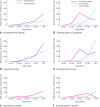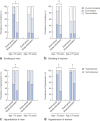Age-specific incidence, risk factors and outcome of acute abdominal aortic aneurysms in a defined population
- PMID: 25955556
- PMCID: PMC4687424
- DOI: 10.1002/bjs.9838
Age-specific incidence, risk factors and outcome of acute abdominal aortic aneurysms in a defined population
Abstract
Background: Contemporary population-based data on age-specific incidence and outcome from acute abdominal aortic aneurysm (AAA) events are needed to understand the impact of risk factor modification and demographic change, and to inform AAA screening policy.
Methods: In a prospective population-based study (Oxfordshire, UK, 2002-2014), event rates, incidence, early case fatality and long-term outcome from all acute AAA events were determined, both overall and in relation to the four main risk factors: smoking, hypertension, male sex and age.
Results: Over the 12-year interval, 103 incident acute AAA events occurred in the study population of 92,728 (men 72·8 per cent; 59·2 per cent 30-day case fatality rate). The incidence per 100,000 population per year was 55 in men aged 65-74 years, but increased to 112 at age 75-84 years and to 298 at age 85 years or above. Some 66·0 per cent of all events occurred in those aged 75 years or more. The incidence at 65-74 years was highest in male smokers (274 per 100,000 population per year); 27 (96 per cent) of 28 events in men aged less than 75 years occurred in ever-smokers. Mean(s.d.) age at event was lowest in current smokers (72·2(7·2) years), compared with that in ex-smokers (81·2(7·0) years) and never-smokers (83·3(7·9) years) (P < 0·001). Hypertension was the predominant risk factor in women (diagnosed in 93 per cent), with 20 (71 per cent) of all 28 events in women occurring in those aged 75 years or above with hypertension. The 30-day case fatality rate increased from 40 per cent at age below 75 years to 69 per cent at age 75 years or more (P = 0·008).
Conclusion: Two-thirds of acute AAA events occurred at age 75 years or above, and more than 25 per cent of events were in women. Taken with the strong associations with smoking and hypertension, these findings could have implications for AAA screening.
© 2015 The Authors. BJS published by John Wiley & Sons Ltd on behalf of BJS Society Ltd.
Figures



References
-
- Office for National Statistics Mortality Statistics Series; 2013. http://www.statistics.gov.uk [accessed 8 April 2014].
-
- Institute for Health Metrics and Evaluation . Global Burden of Disease Study. http://www.healthmetricsandevaluation.org/gbd/visualizations/gbd‐cause‐p... [accessed 8 April 2014].
-
- Heikkinen M, Salenius JP, Auvinen O. Ruptured abdominal aortic aneurysm in a well‐defined geographic area. J Vasc Surg 2002; 36: 291–296. - PubMed
-
- Ashton HA, Buxton MJ, Day NE, Kim LG, Marteau TM, Scott RA et al; Multicentre Aneurysm Screening Study Group. The Multicentre Aneurysm Screening Study (MASS) into the effect of abdominal aortic aneurysm screening on mortality in men: a randomised controlled trial. Lancet 2002; 360: 1531–1539. - PubMed
-
- Dueck AD, Kucey DS, Johnston KW, Alter D, Laupacis A. Survival after ruptured abdominal aortic aneurysm: effect of patient, surgeon, and hospital factors. J Vasc Surg 2004; 39: 1253–1260. - PubMed
Publication types
MeSH terms
Grants and funding
LinkOut - more resources
Full Text Sources
Other Literature Sources
Medical

